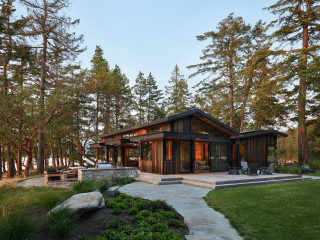
This article was originally published by a www.houzz.com . Read the Original article here. .

This article was originally published by a www.houzz.com . Read the Original article here. .

Cabin at a Glance
Who lives here: A couple
Location: Middleburg, Virginia
Size: 500 square feet (46 square meters)
Architect: Tim Clites of Clites Architects
Contractor: Richard Williams of Deerchase
The cabin sits in a clearing atop a hill, with views of the Bull Run Mountains. “[It’s] an easy walk from the main house, but it’s just far enough to feel like they are getting away,” Clites says.
The couple hired Clites, who had designed the main house, and contractor Richard Williams to make the cabin work for the activities they envisioned. New elements include openings for windows and doors, a chimney, a small addition (seen on the right with wood board-and-batten siding and a pigmented stain) and a back porch.
The late-18th- or early-19th-century cabin originally sat about 70 miles from where it is now. “[It] basically arrived as a bundle of logs,” Clites says. Williams had a bit of a giant Lincoln Logs puzzle on his hands. He and his team laid out the sills and joists on the ground first to see what they had and to get a measurement for the foundation.
Maintaining an authentic historical feel was the goal, but keeping the cabin frozen in time was not. Williams is passionate about old buildings. He paid meticulous attention to detail and sourced reclaimed materials. He also relied on a deep list of contacts, including expert craftspeople, to help give the log cabin authenticity.
One such craftsperson who worked on the project was Lewis Whitesell, an expert mason. He designed and constructed this chimney from fieldstones in a style that would have been used when the cabin was built. Even the firebox is fieldstone rather than firebrick. The half-barrel-shaped cap is a more modern detail that protects the chimney.
Find a local architect on Houzz
This article was originally published by a www.houzz.com . Read the Original article here. .

“In our neck of the woods, there are a lot of rustic looks,” Caruso says. “There are a lot of log cabins, there’s a ton of plaid and antlers and all of that, which is lovely. But it was not what we wanted for this. And so any elements that give a little bit of a sense of rustic is really meant more to add vintage vibes [and] patina.”
For example, a reclaimed-wood ceiling spans the main floor, but the paneled walls are painted crisp white. And the palette, which is mostly shades of blue, green and brown, is pared-back and cohesive throughout the home.
Wall paint: Swiss Coffee, Benjamin Moore
This article was originally published by a www.houzz.com . Read the Original article here. .
Creating the two asymmetrical forms broke up the scale of the house and gave it a San Juan Islands cabin feel. Butrim also looked to agricultural and maritime buildings, as well as Native American longhouses, for architectural inspiration. The materials, which include weathered cedar at random widths, tinted concrete and dark metal roofing, accomplish two goals. They nod to the history of cabins built on this island, and they help the building blend into the wooded site.
“Originally, the front entry led directly into the corridor,” Butrim says. “However, our clients thought that would feel too formal and they wanted this to be a more casual house. It also felt like an entrance you’d have if you’d driven from the road and down the driveway, which doesn’t happen here. Instead, we thought about them entering the house from the approach from the dock.” The front entry is located on the left side of the house. (The door is open in this photo.)